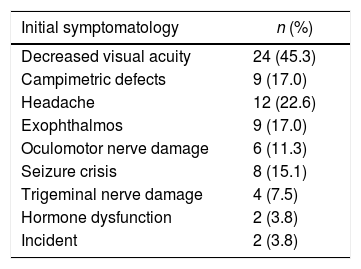The extradural anterior clinoidectomy (EAC) is a key microsurgical technique that facilitates the resection of tumours located in the parasellar region. There is currently no consensus regarding the execution of the procedure via extradural or intradural nor scientific evidence that supports its routine use. The purpose of this article is to expose our experience in performing EAC as part of the management of the parasellar meningiomas.
Materials and methodsA retrospective analysis of the EAC for parasellar meningioma resection performed in our centre between 2003 and 2015 was done. A total of 53 patients were recorded. We analysed our series focusing on visual outcomes, resection rates and complications. Through an extensive bibliographic research, we discussed the advantages and disadvantages of the EAC, technical considerations, comparison with the intradural clinoidectomy and its visual impact.
ResultsThe most frequent tumours were anterior clinoidal meningiomas (33.9%). The most common initial symptoms were decreased visual acuity (45.3%) and headache (22.6%). A gross total resection was achieved in 67.9%, being subtotal in the remaining 32.1%. Regarding the visual deficits 67.9% of the patients presented clinical stability, 22.6% improvement and 9.4% worsening. The degree of tumour resection did not significantly influence post-surgical visual outcomes, either visual acuity (p=0.71) or campimetric alterations (p=0.53). 24.5% of the patients experienced III nerve transient paresis and 1.9% permanent. The postoperative cerebrospinal fluid leak rate was 3.8%. Mortality rate was 0%. The mean follow-up was 82.3 months.
ConclusionsIn our experience, EAC is a safe technique that facilitates the resection of the meningiomas located in the parasellar area, helps to achieve early tumour devascularisation, reduces the need for retraction of the cerebral parenchyma and could play a positive role in the preservation of visual function and the appearance of tumour recurrences in the anterior clinoid process (ACP).
La clinoidectomía anterior extradural (CaE) es una técnica microquirúrgica clave que facilita la resección de tumores localizados en la región paraselar. Actualmente, no existe consenso de la ejecución vía extradural o intradural, o evidencia científica que apoye su uso de manera rutinaria. El propósito de este artículo es exponer nuestra experiencia en la realización de la CaE como parte del manejo de los meningiomas paraselares.
Materiales y métodosSe realizó un análisis retrospectivo de las CaE empleadas en las resecciones de meningiomas paraselares realizadas en nuestro centro entre los años 2003 y 2015. Se registraron un total de 53 pacientes. Realizamos un análisis de nuestra serie de casos, enfocándonos en los resultados visuales, las tasas de resección y las complicaciones postoperatorias. A través de una revisión bibliográfica, se discuten las ventajas e inconvenientes de la CaE, consideraciones técnicas, comparación con la clinoidectomía anterior intradural e impacto visual.
ResultadosEl tipo de tumor más frecuente fueron los meningiomas de clinoides anterior (33,9%). Los síntomas iniciales más frecuentes fueron la disminución de la agudeza visual (45,3%) y la cefalea (22,6%). La resección tumoral total se consiguió en el 67,9% de los casos, siendo subtotal en el restante 32,1%. Con respecto a los déficits visuales, el 67,9% de los pacientes presentaron estabilidad clínica, el 22,6% mejoraron y el 9,4% experimentaron empeoramiento. El grado de resección tumoral no influyó de manera significativa en los resultados visuales posquirúrgicos, ni en la agudeza visual (p=0,71) ni en los déficits campimétricos (p=0,53). El 24,5% de los pacientes experimentaron paresia del III par transitoria y el 1,9%, permanente. La tasa de fístula de líquido cefalorraquídeo postoperatoria fue del 3,8%. La mortalidad fue del 0%. El periodo medio de seguimiento fue de 82,3 meses.
ConclusionesEn nuestra experiencia, la CaE es una técnica segura que facilita la resección de los meningiomas localizados en la región paraselar, favorece la desvascularización temprana del tumor, reduce la necesidad de retracción del parénquima cerebral y podría ejercer un papel positivo en la preservación de la función visual y en la aparición de recidivas tumorales en la apófisis clinoides anterior (ACa).
Article

If it is the first time you have accessed you can obtain your credentials by contacting Elsevier Spain in suscripciones@elsevier.com or by calling our Customer Service at902 88 87 40 if you are calling from Spain or at +34 932 418 800 (from 9 to 18h., GMT + 1) if you are calling outside of Spain.
If you already have your login data, please click here .
If you have forgotten your password you can you can recover it by clicking here and selecting the option ¿I have forgotten my password¿.










